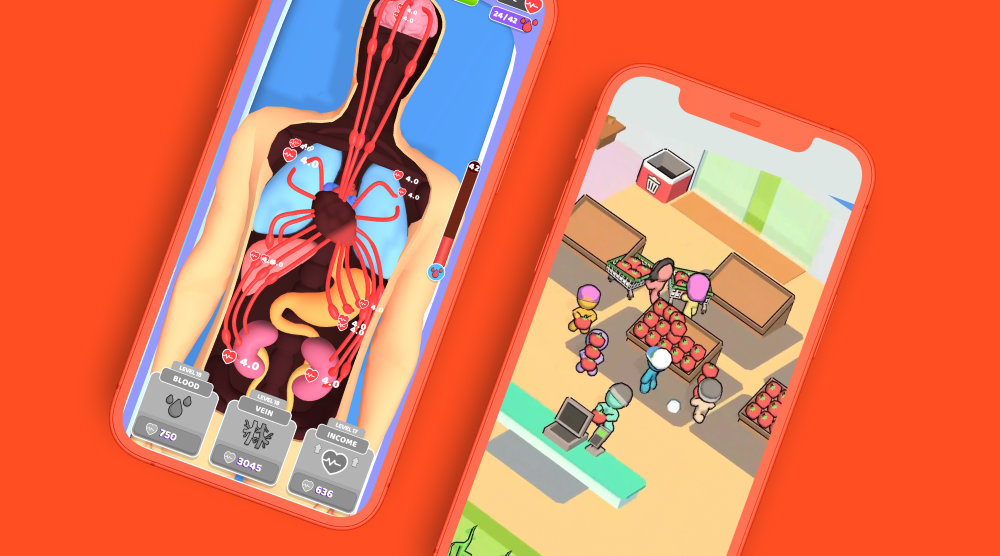Setting your hyper-casual game up to become a profitable hit means applying best practices from the start of the development process - the prototyping phase. Regardless of the sub-genre, there are tips you can consistently follow that will help turn your great idea into an engaging and marketable game. And our publishing team is here to share those tips with you.
In the spirit of transparency and setting our developer partners up for success, the Supersonic publishing team recorded four videos of tips for improving a hyper-casual prototype. From designing creatives that lower CPI to incorporating trending elements that boost in-game metrics, these videos cover all sides of the prototyping process. Keep scrolling to get the expert tips that you can use to set your hyper-casual game up for success from the start.
1. Apply trends from games already submitted
Looking at the games already published and live can help inspire your next game idea - but there’s also incredible value in getting a behind-the-scenes look at the hundreds of prototypes developers have submitted to Supersonic. From these submissions, you can extract high-level insights and trends that give you an ever better glimpse into the future of the top charts than what’s already there. So that’s what Uri Ron, Market Research Expert at Supersonic, is here to do, by sharing the trends he’s seen in the games submitted to our Supersonic Superstars contest:
Of the prototypes submitted, there were three main trending categories:
- Many simulation prototypes were submitted, featuring satisfying or ASMR elements and often inspired by viral TikTok videos
- Idle, idle arcade, and merge games are very popular thanks to their great marketability power, high playtime, and ability to engage users over a long period of time - this leads to higher LTV
- A perennial favorite, runners are still showing they’re relevant. Prototypes with clear themes are tending to have strong marketability and in-game metrics
2. Give a trending mechanic your own twist
At Supersonic, we’re always seeking the next, innovative game - games with unique hooks ensure you’re capturing the attention of new users and engaging them. Players want to see new games and not clones of existing ones - it’s the innovative twist that’ll get their attention in a CPI video and encourage them to play. But what does designing a mechanic with a twist mean in practice for developers? Keynan Tenenbom, Publishing Manager at Supersonic, discusses how to take a trending mechanic and turn it into something new for your own game:
One way to do this is to find a trending mechanic in another genre or hyper-casual sub-genre, then apply it to your game, like taking the mechanic from a puzzle game and applying it to a runner game.
Another option is to combine two existing mechanics - Bridge Race did this with a stacking mechanic from runner games and an IO racing mechanic. Stacky Dash is another example of this, combining a puzzle mechanic inspired from other hyper-casual games with a stacking mechanic. It’s achieving that balance of completely new ideas with existing, proven features that’s important for building a marketable yet innovative prototype.
3. Test more prototypes, more quickly
Working quickly and efficiently is key in the hyper-casual market, where the top charts are changing all the time and competition is always high - the more prototypes you can test, the higher your chances of finding a successful game. So the more quickly you can develop and test prototypes, the better. Here providing her tips on testing more titles and improving development speed is Gal Balas, Publishing Manager at Supersonic:
Before diving deeper into this, here are three quick tips to improve development speed:
- Set a deadline to complete and test your prototype - and stick to it
- Create generic templates you can apply to this game (and the next that you build)
- Be organized
Now taking a deeper dive, it’s important to prioritize - don’t build a full game when you’re in the prototyping phase. At this point, publishers are only looking to see the core of your game to confirm if it has potential. Think about what parts of your game provide the most value to users and are likely to be the most marketable and engaging; this is that “core” a publishing team is looking for. This means focusing on strong execution and visual feedback that gives users a clear understanding of the goal of the game and keeps them engaged.
4. Show off the engaging parts of your game in creatives to lower CPI
Once you’ve honed your mechanic and theme, it’s time to think about your creatives. The CPI video is your opportunity to prove the marketability of your prototype by showing off the most engaging parts. Maya Kochol, Publishing Manager at Supersonic, shares tips and examples for doing just this so you can lower CPI:
Starting with gate runners as an example, you should highlight the decision-making and evolution aspects in the creative since this is usually the main hook. In your CPI video, show the character going through at least a few gates and the different transformations that occur each time.
Next, looking at idle arcade games, the focus of your creative should be on stacking and upgrading because this will show off the constant progress that appeals to users.
For simulation and idle games, it’s all about satisfying gameplay. So highlight the visual upgrades of your game and make sure the goal, controls, and rules of the game are as clear as possible within the first few seconds of your creative.
5. Improve in-game metrics with trending features
It’s time to turn the attention to in-game metrics like retention and playtime. However, don’t spend too much time trying to improve these metrics because you’ll work with a publisher to help build out the game and improve the user experience. It’s worth thinking about in-game performance, but only focus on the basics. For this, we go to Kemal Levi Levent, Publishing Team Leader at Supersonic, who shares his insights on current hyper-casual trends that are helping boost in-game KPIs:
Right now, upgrade systems are trending in many hyper-casual games. This can look like users earning coins by playing through a level, then spending those coins in the next levels to upgrade their character and powers. You can demonstrate upgrades with visual progression, too, like showing a level map increasing in size and becoming more complex as players move through the game.
Another trend worth noting is unlocking new items - this is especially popular in hyper-casual merge games where new objects are unlocked as users play through the game and continue merging items.
With these tips from the publishing experts, it’s time to go and create a prototype for your next hit. We’re here to help - when you submit your game for testing, look out for our feedback to help you improve the next version. We can’t wait to see your prototype!
Let's put these tips to good use
Publish your game with Supersonic



